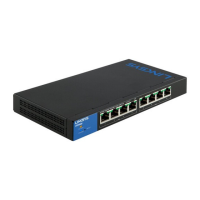97
Table of Contents
Linksys
Table of Contents
Linksys
STEP 1 Click Configuration > Quality of Service > Basic QoS.
STEP 2 Select the Trust Mode while the device is in Basic mode. The Trust
mode determines the queue to which the packet is assigned:
• CoS/802.1p—Traffic is mapped to queues based on the VPT field in the
VLAN tag, or based on the per-port default CoS/802.1p value (if there is
no VLAN tag on the incoming packet), the actual mapping of the VPT to
queue can be configured in the mapping CoS/802.1p to Queue page.
• DSCP—All IP traffic is mapped to queues based on the DSCP field in the
IP header. The actual mapping of the DSCP to queue can be configured in
the DSCP to Queue page. If traffic is not IP traffic, it is mapped to the best
effort queue.
• CoS/802.1p-DSCP—All IP traffic is mapped to queues based on the values
in their DSCP field. All non IP traffic is mapped to queues based on the
their CoS/802.1p value.
• To disable QoS on a port, click Edit.
• Select a port or LAG.
• Disable QoS on the port or LAG.
STEP 3 Click Apply. The Running Configuration file is updated with the
new settings.
QoS Statistics
Queues Statistics
The Queues Statistics page displays queue statistics, including statistics of
forwarded and dropped packets, based on interface, queue, and
drop precedence.
To view Queues Statistics:
STEP 1 Click Configuration > Quality of Service > QoS Statistics > Queues
Statistics.
This page displays the following fields:
• Refresh Rate—Select the time period that passes before the interface
Ethernet statistics are refreshed. The available options are:
• No Refresh—Statistics are not refreshed.
• 15 Sec—Statistics are refreshed every 15 seconds.
• 30 Sec—Statistics are refreshed every 30 seconds.
• 60 Sec—Statistics are refreshed every 60 seconds.
• Counter Set—The options are:
• Set 1—Displays the statistics for Set 1 that contains all interfaces and
queues with a high DP (Drop Precedence).
• Set 2—Displays the statistics for Set 2 that contains all interfaces and
queues with a low DP.
• Interface—Queue statistics are displayed for this interface.
• Queue—Packets were forwarded or tail dropped from this queue.
• Drop Precedence—Lowest drop precedence has the lowest probability of
being dropped.
• Total Packets—Number of packets forwarded or tail dropped.
• Tail Drop Packets—Percentage of packets that were tail dropped.
STEP 2 Click Add.
STEP 3 Enter the parameters.
• Counter Set—Select the counter set:
• Set 1—Displays the statistics for Set 1 that contains all interfaces and
queues with a high DP (Drop Precedence).
• Set 2—Displays the statistics for Set 2 that contains all interfaces and
queues with a low DP.
• Interface—Select the ports for which statistics are displayed. The options are:
• Port—Selects the port on the selected unit number for which
statistics are displayed.
• All Ports—Specifies that statistics are displayed for all ports.
• Queue—Select the queue for which statistics are displayed.
• Drop Precedence—Enter drop precedence that indicates the probability
of being dropped.
STEP 4 Click Apply. The Queue Statistics counter is added, and the Running
Configuration file is updated.

